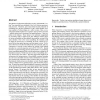93 search results - page 17 / 19 » Cognitive Simulation in Virtual Patients |
APGV
2005
ACM
14 years 2 months ago
2005
ACM
The illusion of self-motion induced by moving visual stimuli (“vection”) has typically been attributed to low-level, bottom-up perceptual processes. Therefore, past research h...
ICMI
2003
Springer
14 years 2 months ago
2003
Springer
Many user interfaces, from graphic design programs to navigation aids in cars, share a virtual space with the user. Such applications are often ideal candidates for speech interfa...
HCI
2007
13 years 10 months ago
2007
State-of-the-art computer graphics can give autonomous agents a compelling appearance as animated virtual characters. Typically the agents are directly responsible for controlling ...
ATC
2010
Springer
13 years 8 months ago
2010
Springer
Co-Space refers to interactive virtual environment modelled after the real world we are situated in. Through realistic 3D modelling and animation technologies, Co-Space simulates t...
CE
2007
13 years 9 months ago
2007
The two separate projects described have examined how teachers exploit computer-based technologies in supporting learning of science at secondary level. This paper examines how pe...

